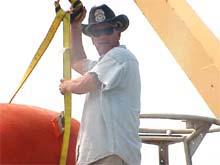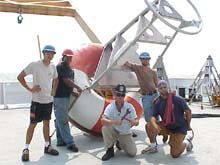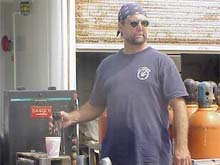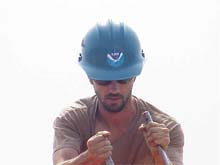
As Chief Bosun, one of Bruce Cowden's jobs is to ensure that all scientific equipment used on the Ron Brown is deployed and recovered correctly. Bruce also must make sure that everything is done safety and in an organized manner, minimizing the risk of injury or damage to both equipment and crew. Click image for larger view.
We are the Ronald H. Brown
The Deck Department
Bruce Cowden - Chief Bosun
September 5, 2002
Lisa M. Weiss, Watershed Coordinator
Jacques Cousteau National Estuarine Research Reserve
From the time that the ship is loaded for its next mission, through the time it leaves its berth, during the collection of scientific data and back to its next in-port, the deck crew of the Ron Brown is working constantly to assist with scientific missions. Many of the machines and instruments that are used to collect data are not easily deployed or maintained. In addition, as the prized ship of the NOAA fleet, the Ron Brown has to sustain an appearance of professionalism and stateliness. It represents NOAA's mission of documenting, predicting and understanding global change within the natural environment. All these tasks, and more, are the responsibilities of the Bosun and his deck crew.
For each mission undertaken by the Ron Brown, scientific equipment must be loaded, stored and secured before the ship can leave the dock. Upon in-porting, the deck crew must off-load all the equipment from the previous trip and on-load all the equipment that is necessary for the next trip and future trips. While underway, the deck crew ensures the integrity of the vessel by painting and chipping rust from the hull. Under harsh conditions at sea, such as the constant wind, sun and salt exposure, the ship can experience intense corrosive damage if not properly maintained.

A common source of bioluminescence in the pelagic zone include fish, squid, shrimp and jellyfish. Click image for larger view.
Tasks such as tying up at berths, hauling in lines, getting underway and anchoring are also part of the deck crew's responsibilities. To fulfill these duties, the deck department is trained in the operation of machinery like winches, cranes, capstans and A-frames. This equipment is necessary for loading and unloading of equipment, and is used for the deployment and the recovery of all scientific equipment.
All members of the crew are trained in fire, rescue and boat operations, CPR and first aid. The deck crew serve as firefighters when necessary and deploy, launch and drive the rescue and outboard boats during the course of normal operations and under emergency situations. Deck crew members also stand watch on the bridge, 24 hours a day, looking for other ships, debris, and mariners in distress.
Crew operators also are responsible for Tropical Atmospheric Ocean (TAO) buoys. These buoys are placed in a grid throughout the tropical South Pacific. They stretch across the equator to the International Dateline. Armed with instruments that measure temperature, wind speed and direction, and pressure, the TAO buoys help forecast El Niño events. El Niño is an ocean and atmospheric phenomenon that occurs in cycles, bringing with it conditions such as droughts. The TAO project began in the 1980s and, because of its predictive capabilities, has continued for over two decades. Every six months, the buoys have to be replaced, along with the instrumentation that they carry. The Ron Brown will be heading to the TAO grid in October to work on buoy maintenance.

Dave, another member of the deck crew, working the winch during assembly of a TAO buoy. Deck crew members are trained to use the cranes, winches, capstans, A-frame, fire equipment and rescue boats.
Bruce, the Chief Bosun, has been at sea for nearly his whole life. He began his career on the oceans at age 17, off the coast of the Carolinas, working on shrimping and fishing vessels. Because he wanted to go to the Orient and the Pacific Oceans, Bruce joined the Navy and was stationed on the West Coast. While in the Navy, he sailed the Pacific and Indian Oceans and traveled to Africa, the Orient and the Middle East. Bruce returned to the East Coast where he was stationed in Charleston, South Carolina, working on mine sweeper ships (to detect and destroy mines in the ocean).
Five years after his Naval experience, Bruce continued to work in Charleston at ship yards and on boats, shrimpers and tugs. He started his work for NOAA on the Malcolm Baldrige, then worked on the Ferrel. He has also worked as a research diver and captain of vessels and remotely operated vehicles for NOAA's Grey's Reef National Marine Sanctuary in Savannah, Georgia. Bruce has worked as Chief Bosun aboard the Ron Brown for about two and a half years.

Brad, a member of the deck crew working on the TAO buoy. The deck crew has many duties including anchoring, tying-up and getting the ship underway, exterior maintenance of the ship and operation of the on-deck machinery. Click image for larger view.
According to Bruce, every scientific expedition brings new challenges. He and his crew constantly have a whole new set of equipment and people. To pass his time at sea, Bruce has developed many hobbies such as reading, drawing, carving and working on children's nautical and science books. He also is a big fan of the nightly movies and spends time emailing his family at home in Charleston. As Bruce puts it, "Old dogs can, and have to, learn new tricks."
Sign up for the Ocean Explorer E-mail Update List.























